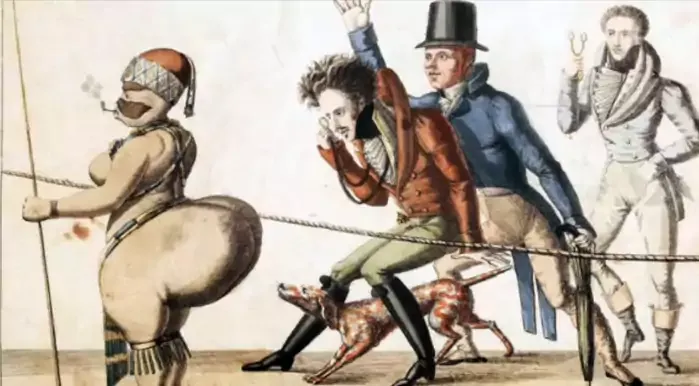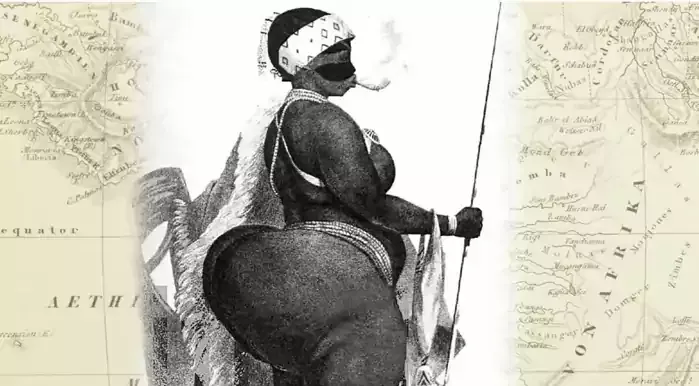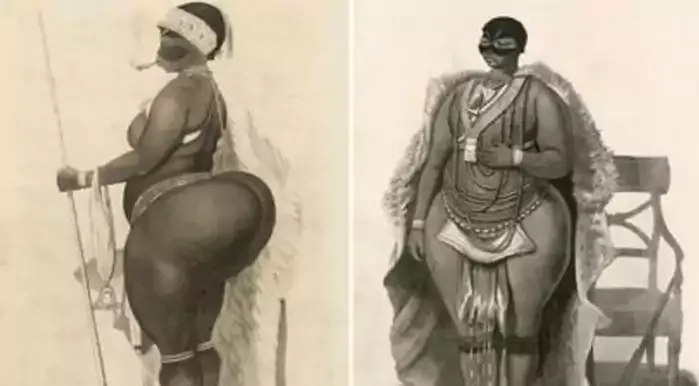Sarah Baartman was born in 1789 in the Eastern Cape of South Africa. She was a subsistence herdsman in Khoekhoen. Her family were servants of a colonial family. Her mother died when she was two years old and her father before she was a teenager. Sarah is married to a drummer from Khai, they had a child in that relationship.
Sarah Baartman's stage performance
Painful Story: Sarah Baartman 'African Caged-Slave Girl' Biography
The colonization intensified in Eastern Cape of South Africa there at this time, and the Dutch were mercilessly killing blacks that include her husband. She was 16 years old when her husband was killed. They did not kill Sarah because of her strange appearance. Instead, they sold her to a merchant named Peter William Peter Cezar for a high price, he took her to Cape Town. There she was tortured and humiliated at the home of Peter's brother Henry and pushed into slavery.
In 810 on October 29, the English ship surgeon William Dunlop came to see her. The man who saw Sarah's physical deformity had a commercial interest in her. In his mind were the infinite possibilities of the market that would arise if she were an exhibition object for Europe.
Saartjie Baartman exhibition
It is widely rumoured that she went on her own with Dunlop on one condition that she would go to England and Ireland and do housework there and be allowed to exhibit also if she received a share of the proceeds, but that was not so credible. There are two reasons for this. One, it is doubtful that she signed the contract, and she was as illiterate as the African slaves of the day. Second, the Cezar family was facing a major financial crisis at the time, and they must have used Sarah.
She arrived in England in late 1810. He wrote a huge slogan, "Caged African Bipedal" and invited spectators to the ticket. The English came in droves to see Sarah's naked body displayed in a cage only a meter high. She suddenly attracted people from different parts of Europe because it was a time when black bodies were not even seen rarely, in Europe. The whites found cruel pleasure in pinching and grabbing Sarah, who was squeezing inside the cage without covering her body like an animal.
Meanwhile, it was a time when humanitarian campaigns against slavery were gaining strength in Britain. Naturally, Sarah Baartman's denial was also questioned. But Dunlop slipped out of the law by giving Sarah a fake testimony that she agreed to exhibit. He brutally exploited her and made a lot of money.
In September 1814, protests against Sarah's exhibition in England intensified and she was taken to France.
Sarah Baartman, Saartjie Baartman African Caged-Slave
The French circus performer Reaux bought her from Dunlop for a high price. He taught her and the spectators the tricks of seducing them, just as he taught tigers and elephants. He commanded her like animals, even though she had two legs, Sarah was a beast in his eyes!
Rachel Holmes, the author of The Hottentot Venus: The Life and Death of Saartjie Baartman says You have to remember that, at the time, it was highly fashionable and desirable for women to have large bottoms, so lots of people envied what she had naturally, without having to accentuate her figure.
Clifton Crais and Pamela Scully, author of the book "Sara Baartman and the Hottentot Venus: A ghost story and a biography", portraying Sarah's gloomy life said: Her first name is the Cape Dutch form for "Sarah" which marked her as a colonialist's servant. "Saartje" the diminutive, was also a sign of affection. Encoded in her first name were the tensions of affection and exploitation. Her surname literally means "bearded man" in Dutch. It also means uncivilized, uncouth, barbarous, savage. Saartjie Baartman – the savage servant.
At one point, she had a collar around her neck like an animal. The people of France greeted Sarah with great enthusiasm. On cold, snowy nights, he had to live with the wild beasts without even a thread to cover. The fact that she was on display in a cage with the rhino most days shows the depth of the cruelty she faced, she was exhibited completely naked.
Sarah Baartman died on 29 December 1815
Due to her stubbornness, she was sometimes allowed to cover only the front with a little longer than her waist. Sarah's health was deteriorating day by day in the bitter cold of Paris. Probably because she was treated like an animal, the circus performer did not give her proper care. She said goodbye to the cruel world in 1816, at the age of 27, as a symbol of the black people who had suffered the most. She died of pneumonia, syphilis or alcoholism. But unfortunately or by the white's cruelty, she remained an object of display even after her death. Her naked body was kept in the Paris Museum until 1974, special coatings were applied to prevent decomposing. Her organs were later amputated and kept for research.
By the 1940s, strong struggles began to emerge to bring Sarah's remains back to her homeland. Sarah's story is retold around the world in 1981 by palaeontologist Stephen Jay Gould in "The Mismeasure of Man". With this, Sarah's appeal for her rights gained global prominence. The poem "I have come to take you home" by Diana Ferrus, has played a significant role in stimulating these movements.
Sarah Baartman's exhibition on stage
With the victory of the African National Congress in the 1994 general election, Nelson Mandela called on France to release Sarah's physical body. France approved the request on March 6, 2002, after several legal battles and debates in the French National Assembly. On May 6, her remains were returned to Gamtoos Valley. The remains of Sarah Baartman are buried with full honours in a modest grave in the tiny farming village of Hankey in the Eastern Cape.
The documentary "The Life and Times of Sara Baartman" of 1998, and the film "Black Venus", released in 2010 have covered her miserable life story, for those outside South Africa who are unaware of Baartman.
Today, Sarah Bartman, a representative of the country's history and ethnicity, is an icon of South Africa.
Cape Town, the shelter launched in 1999 for domestic violence victims has been renamed the "Saartjie Baartman Centre for Women and Children". South Africa's first offshore nature conservation ship is also known as Sarah. The hall in the centre of the Cape Town University campus was later renamed, Sarah Baartman Hall.









